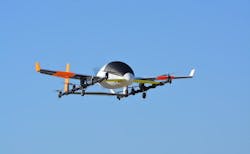AI and safety considerations in commercial autonomous aircraft
Editor’s note: This article—which details an interview with Mercury Systems and Daedalean on an artificial intelligence system for autonomous aircraft—is continued from page one.
FARNBOROUGH, England –Given the focus of this technology, Song was excited to see that—at this year’s trade show—UAVs have a larger presence at the Farnborough International Show.
“The UAV market is growing and thriving,” Song continued. “I’ve been coming to Farnborough/Paris for a long time and it seems that this is the first time that UAVs are on display in a commercial capacity.”
Related to this, as well as the AI-based technology the two companies are working on, the "electric vertical take-off and landing" (EVTOL) market is another that is gaining steam.
“We want to ultimately carry passengers autonomously,” said Videnov. “The product we are developing with Mercury Systems could ultimately be deployed to do that.”
This particular technology is one that is quite relevant for those looking to deploy so-called “sky taxi” autonomous aerial vehicles.”
Videnov noted that Daedalean is partnering with the companies working on this already, and that they are developing software for them. In terms of when this technology (EVTOL) could become commercially available, he noted that perhaps it could be as soon as five years, but anyone ultimately working on this technology has to be flight-safety certification focused.
Song agreed, noting that there is a lot of hype with this technology, but Daedalean is doing the right thing by starting with safety as a consideration first.
“People need to understand how important it is to take safety and certification up front and to really understand—from both a hardware and software perspective— what ‘safety critical’ hardware and software really is,” he said.
While artificial intelligence offers an abundance of promise for commercial, general, and defense aviation, not everyone looking to deploy it may be successful, according to Song.
“Many companies are utilizing artificial intelligence from both a software and hardware perspective, but it will shake out due to things like funding and technology,” he said. “Additionally, it will shake out because people don’t understand the importance of safety certification and how it applies to contemporary technology. This needs to happen before any type of product is developed. Otherwise, the investment may be for naught.”
Looking forward, Song offered a glimpse in the potential future of aviation for commercial, general, and defense applications.
“Aviation 2.0 is coming, and it’s coming much sooner than people think,” he said. “This is especially true in the commercial domain. Commercial aviation is taking the lead in areas such as sensor integration, centralized processing and safety certification, both are required for modern avionic platforms.”
Keep an eye on this space, he suggested.
View more information on Mercury Systems.
View more information on Daedalean.
